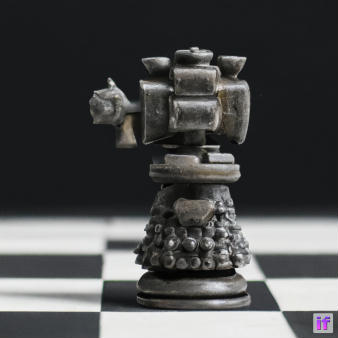Comments/Ratings for a Single Item
 Iyad wrote on Fri, Jul 26, 2002 07:09 PM UTC:Good ★★★★
Iyad wrote on Fri, Jul 26, 2002 07:09 PM UTC:Good ★★★★ Charles Gilman wrote on Sun, Apr 27, 2003 10:15 AM UTC:
Charles Gilman wrote on Sun, Apr 27, 2003 10:15 AM UTC: Charles Gilman wrote on Sat, Oct 4, 2003 06:04 AM UTC:
Charles Gilman wrote on Sat, Oct 4, 2003 06:04 AM UTC:(Partial reply to your post. You mentioned several topics.) I assume you mean a Dabbaba-analog on a hex board, using the Glinski-based analogy to FIDE chess. Mapping the hex board onto a standard chessboard (where the 91 Glinski hex board >> diagonal oriented 11x11 chessboard with 15 squares cut from each of the two side corners, for example) helps clarify the situation: the h-Dabbaba is more strictly equivalent to a true Dabbaba plus half an Alfil and, since the Alfil adds nothing to the Dabbaba's possible squares, the net effect is (not so surprisingly) the same type of boundedness as the true Dabbaba. One type of 'half-bound' piece on the hex board would be a piece moving in any single h-Rooks direction (e.g., N-S) and in the perpendicular h-Bishop direction -- its a FIDE Bishop. A conventional Camel is also possible, as are any other half-bound pieces mapped from a square-tiled chessboard.
There is nothing especially simple, elemental, basic or natural about the rules for movement proposed by Glinski in developing a chess variant played on a hexagonal board -- in fact, the Glinski-B interpretation is considered something of a kluge by some CV designers (others view it more favorably). Other interpretations are not 'exotic' -- they are simply other, currently less well-explored, possibilities for defining movement. As I see it, Glinski's 'Hexagonal Chess' is fully equivalent to a game with half-Bishop + half-NRider (g-Bishops), Rook + half-Bishop (g-Rooks), half-N + half-Zebra + half-Camel (g-Knights), Rook + Bishop + half-NRider (g-Queens), King + half-Knight (g-Kings), and Berolina-type pawns (g-Pawns) played on a portion of an diagonally-oriented 11x11 chessboard. (Oddly enough, it's still an interesting game). I personally feel it might be better to embrace this equivalence (and others like it) rather than insist on somewhat arbitrary distinctions between hexagonal- and square-tiled playing fields.
 Charles Gilman wrote on Mon, Mar 22, 2004 10:20 AM UTC:Good ★★★★
Charles Gilman wrote on Mon, Mar 22, 2004 10:20 AM UTC:Good ★★★★ John Ayer wrote on Thu, Sep 16, 2004 02:18 AM UTC:Good ★★★★
John Ayer wrote on Thu, Sep 16, 2004 02:18 AM UTC:Good ★★★★The Arts and Science pages of the Case Western Reserve University Medieval Society have movement definitions and diagrams for many pieces from old shatranj variants. A pair of 10x10 variants (both called Shatranj Kamil) are believed to date back 1000 years. One added the orthogonal leaper we now call the Dabbabah. The other variant added a (nonroyal) King.
Courier Chess uses the wazir under the name 'schleich', which is sometimes translated as 'fool'. Ralph Betza may be the first to use the 'wazir-dabbabah' piece in a chess variant, but there are also the 'knights' in Cohen's Error Chess (1977). Jean-Louis Cazaux calls this piece a 'machine' in his 14 x 14 variant Gigachess (2001).
Since I changed the AI image for this piece, here is the old one for comparison:

I think, the piece name should be spelled Dabbaba (without an H at the end), the underlying Arabic does not have it either.
Here's the Wiktionary entry with more information on the original Arabic word: https://en.wiktionary.org/wiki/dabbaba
دَبَّابَة
Although "ت" usually has a "t" sound, it becomes "ة", & has an "h" sound instead if the letter is at the end.
The Arabic singular is just دَبَّابَة (dabbāba), the "ت" only occurs in the plural دَبَّابَات (dabbābāt).
See: https://en.wiktionary.org/wiki/%D8%AF%D8%A8%D8%A7%D8%A8%D8%A9#Arabic
Here's the Wiktionary entry with more information on the original Arabic word: https://en.wiktionary.org/wiki/dabbaba
Oh, accidentally there’s my SVG)))
I think, the piece name should be spelled Dabbaba (without an H at the end), the underlying Arabic does not have it either.
I have updated the first paragraph to cover how the word has been spelled in printed Chess variant literature. Since Dabbabah is one of the spellings that has been used in print, and I don't want to change the URL of this page, I am sticking with it for this page, though I do note some reasons one could prefer Dabbaba.
This ة is a variant of the letter ت.
19 comments displayed
Permalink to the exact comments currently displayed.